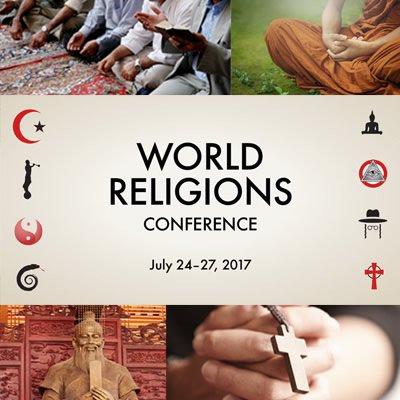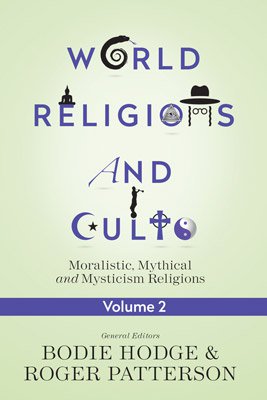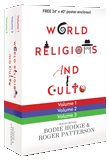We Love Sin!
A young girl named Rachel decided to serve as a counselor at a Christian camp in the summer of 2014. She expected the usual mix of Christians who wanted to grow in their faith in an exciting environment, others undecided about what to believe who were there mainly for the fun, and some who were forced to go but didn’t really want to be there at all.
What Rachel didn’t expect was a few professing Wiccans (modern day pagan witches) who decided to make their beliefs known in a rather disturbing way. Acting in unison one night, they refused to obey the rules and began to shout, “We love sin.” Campus security had to be called to quell the disturbance. The church group that brought the girls to camp was hoping to give them an exposure to the Christian way of life, not knowing what they truly believed.
This might be easy to write off as a few young girls seeking nothing more than attention, but their aberrant behavior was disturbing and frightening to other campers. Were they really part of the pagan community attracted to witchcraft? Probably not, because Wiccans do not believe in sin by Christian definition, but these young girls may have been familiar with Wicca to some extent and could very well adopt it as their personal expression of spirituality in the future.
Out of the Shadows
Paganism is a religion that has been experiencing growth in America since the 1960s, although the number of pagans is difficult to track. Many people don’t openly admit to their belief in paganism, and pagans don’t belong to denominations or structured religious groups. There are loose associations that cooperate, but paganism is an eclectic worldview that encompasses many specific views. You won’t see a recognizable pagan meeting place like a church or synagogue, and pagans don’t go door-to-door seeking converts like the Mormons and Jehovah’s Witnesses.
Paganism is not as concerned about the growth and spread of their beliefs as much as the personal growth of the individual in what some simply refer to as “the craft.” As a prelude, paganism can be expressed as ancient spiritism, Wicca, Druidism, witchcraft, polytheistic mythologies of the past, and a host of other variations.1 In a practical sense, pagans value their own experience above all else. The majority of pagans are solitary and prefer to keep their religion to themselves. “Learning the craft” is being schooled in the beliefs and literature of the pagan way of life.

In a certain sense you don’t become a pagan; you are a pagan. It is more of an inner discovery than a conversion. However, the Internet has helped pagans make their beliefs better known in a “try-before-you-buy” approach. It has moved paganism out of the closet — or should I say, the broom closet. Yes, brooms still have their place among the pagans, and not just at Halloween. They are used to symbolically sweep a place clean for certain rituals and in Wiccan handfast ceremonies.2 In a handfast ceremony, two Wiccans make a binding commitment to each other for a certain period of time as a prelude to marriage, or the ceremony can be incorporated into an actual marriage ceremony. Sometimes the participants will jump over the broom at the end of the ceremony. When the bride and groom jump the broom at the end of the ceremony, they are sweeping the past away and jumping into their future together!
Symbolism
Paganism employs many different symbols and symbolic actions like jumping the broom, but there is more to it than mere symbolism. Pagans will use various types of incense and candles on an altar to achieve certain objectives. Incense is believed to have therapeutic properties and is used in rites of purification. The same is true of essential oils, and various fragrant flowers and herbs are likewise employed to manipulate energies. An advertisement for a female human figure candle on the products page of a pagan online store called The Magickal Cat reads as follows:
This reversible candle is made with black wax over red wax. Charged with reversing magic, it is intended to aid in returning negative energies and attentions to their source, leaving your enemies tasting what they have served. The female image in this candle can be particularly helpful if you are also calling upon the Goddess, using the candle to help protect a woman, or returning the negative energies in question to a woman.3

The Magickal Cat also sells a basic “Wiccan/Pagan altar set,” scrying bowls, tarot cards, pendulums, spell-casting supplies, wands, gemstones, and your very own crystal ball, in addition to many other enchanting and exotic items to fill your pagan toolbox. It’s kind of like an all-in-one, do-it-yourself pagan version of a home improvement store conveniently located on your computer. Pagans also use black cauldrons as pots to hold fire in which to brew potions. The witches’ spell in Shakespeare’s Macbeth contained the lines, “Double, double toil and trouble; Fire burn, and cauldron bubble.”
Moving Toward Paganism
The move out of the shadows by pagans can be seen by Christian apologists as a good thing in some ways, because it also reveals the darkness of paganism masquerading as light. The Bible gives repeated warnings about Satan’s strategy to deceive in this manner (2 Corinthians 11:14). He is the “father of lies” (John 8:44). The world of false religion has many different shades of deception, and the lure of a powerful personal experience is a particularly attractive hue. Satan’s first great lie to Eve in Genesis 3:5 included the promise of power and great enlightenment: “For God doth know that in the day ye eat thereof, then your eyes shall be opened, and ye shall be as gods, knowing good and evil.”4 This is what makes paganism so dangerous and attracts so many people to the New Age movement.
In addition, people are gullible by nature and tend toward sinful desires, especially those who are more open-minded to spiritual matters and personal growth apart from the wisdom and discernment that come from God’s Word. Just witness the constant bombardment of products that the average person is subjected to every day. The advertisers know that if they can offer you something to enhance your life, it will probably sell. Highlight the benefits of a certain product and put it in an attractive package and people will buy it. It’s a basic sales pitch, and Satan has a great marketing strategy to enlarge his kingdom of the cults and the occult.5 Infomercials work because the claim is “Here is what I can do for you now.” Paganism has the same message: “Here is what I can do for you now.” The payoff is in this world, not a world to come.
People who have been disenchanted with organized religion constitute another class of potential pagans. They have tried other religious products, so to speak, and they did not work for them. These spiritual dropouts from the more traditional faiths may find the paganism packaging attractive, and when they buy it, they also find acceptance and encouragement to express their own beliefs rather than conform to a standard. They no longer feel like outsiders; they have become insiders. It’s like belonging to a special club with all kinds of nice perks without the baggage of membership standards and dues.
Furthermore, the pagan man or woman can climb the ladder of paganism as high as they desire to go. There is no “top rung,” and there is nothing like the clergy-laity separation they likely experienced in organized religion. Each person belongs to the priestly class in paganism, although advancement in the pagan covens (esbats) may take time. The prominent American pagan witch Starhawk defined the coven as “a Witches support group, consciousness-raising group, psychic study center, College of mysteries, surrogate clan, and religious congregation all rolled into one.”6 On her personal web page under the listing “About Starhawk” we find the following:
- Starhawk is one of the most respected voices in modern earth-based spirituality. She is also well-known as a global justice activist and organizer, whose work and writings have inspired many to action.
- Starhawk is perhaps best known as an articulate pioneer in the revival of earth-based spirituality and Goddess religion. She is a cofounder of Reclaiming, an activist branch of modern Pagan religion, and continues to work closely with the Reclaiming community. Her archives are maintained at the Graduate Theological Union library in Berkeley, California.
- Starhawk is a veteran of progressive movements, from anti-war to anti-nukes, and is deeply committed to bringing the techniques and creative power of spirituality to political activism.
- Starhawk travels internationally teaching magic, the tools of ritual, and the skills of activism. She lives part-time in San Francisco, in a collective house with her partner and friends, and part-time in a little hut in the woods in western Sonoma County, California, where she practices permaculture in her extensive gardens, and writes.7
Like many traditional religions, paganism does not discriminate on the basis of age or gender, and women constitute the majority of pagans overall. This should not come as a surprise given the fact that in a masculine-dominated society, there are women seeking liberation and empowerment. Among the open-minded, the young spiritual explorers often dabble in some form of paganism often influenced by its prevalence and positive portrayals in popular media. Catherine Sanders notes, “The book Teen Witch: Wicca for a New Generation has sold more copies for occult publisher Llewellyn than any other in its 95-year history.”8 Ruth La Ferla writes of two teenage witches:
Ms. Trayer and Ms. Haddad-Friedman are members of a movement gaining an ardent following among teenagers, mostly girls, who are in part captivated by the glossy new image of witches portrayed on television shows and in the movies. No longer the hideous, wart-covered crone of folklore and fairy tale, witches in hit television shows like “Charmed,’’ starring Shannen Doherty, and the 1996 movie “The Craft,’’ a favorite with teenagers at video stores, are avatars of glamour, power and style. Other youthful adherents of Wicca, seeking an alternative path to spirituality, are attracted by the craft’s lack of structure and dogma.9
Paganism and the Wiccan Connection
The term pagan comes from a Latin word for “country or village dweller” and was first used in the early Christian era in a broad sense to refer to the unconverted. In current usage, the word pagan is often associated with someone who behaves contrary to established norms. We often envision pagans as people with multiple body piercings, brightly colored hair, strange tattoos, and strange music. That stereotype does an injustice to the true nature of paganism; it’s not about a certain outward appearance. You might find pagans fitting that mold, but you will also find them dressed in casual clothes or a business suit. They are typically middle class, educated, and come from all walks of life.
In the religious or spiritual sense, modern paganism, often referred to as neo-paganism, is more concentrated in Britain, North America, Australia, and New Zealand, according to author Barbara Jane Davy.10 Although paganism is definitely not a mainstream religion like Protestantism, Catholicism, Buddhism, Islam, or Hinduism, pagans see it differently. They believe that paganism is the original religion from which all other religions eventually developed. This is not the case (as various forms of paganism are actually a corruption of the truth as it was passed down since Noah), but there is an association of the word pagan with ancient religious traditions and heritage.

Cadet Chapel Falcon Circle, located on the hill top between the Academy Visitors Center and the Cadet Chapel, is dedicated May 6, 2011. (Wikimedia Commons, U.S. Air Force/Photo by Mike Kaplan)
Some Wiccans refer to Wicca as the “Old Religion.” Gerald Gardner, an Englishman, is considered the man who did the most to popularize modern Witchcraft and establish the Wiccan traditions beginning in the late 1930s. He said that the “Old Religion” had followers who preceded him, the religion having survived from the Middle Ages. However, Gardner’s credibility is not without its doubters. In an essay titled, “History of Wicca in England: 1939 to the Present Day,” author Julia Phillips, a Wiccan high priestess writes:
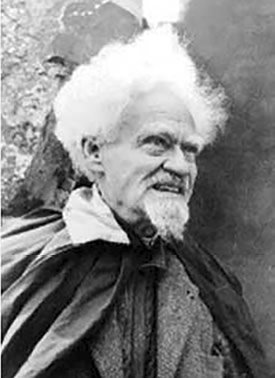
Gerald Gardner
Of course we can never really know the truth about the origins of the Wicca. Gardner may have been an utter fraud; he may have actually received a “Traditional” initiation; or, as a number of people have suggested, he may have created the Wicca as a result of a genuine religious experience, drawing upon his extensive literary and magical knowledge to create, or help create, the rites and philosophy. What I think we can be fairly certain about is that he was sincere in his belief. If there had been no more to the whole thing than an old man’s fantasy, then the Wicca would not have grown to be the force that it is today.11
Gardner’s book, Witchcraft Today, published in 1954, was instrumental in the growth of American paganism, although he certainly leaned on others in his writing. He borrowed some of the rituals, which he incorporated into Wicca from a variety of sources including a Rosicrucian group, Kabbalah (a mystical offshoot of Judaism), the works of Aleister Crowley, and Free Masonry. For example, Gardner adopted the three-degree initiation rite of the Masonic order in his witchcraft.
Two of Gardner’s followers, Rosemary and Raymond Buckland, established a coven in New York in 1964. In 1968, Buckland opened the Museum of Witchcraft and Magick on Long Island, New York. He has authored over 50 books, both fiction and nonfiction, the majority of them about witchcraft and magic. Wicca now had a foothold on American soil and would eventually spread westward. The first large gathering of pagans in the United States occurred in 1979 at the Pan-Pagan Festival in Indiana. These festivals provide a place and time for pagans to come together in a supportive environment to learn from one another and develop their individual skills in the craft.
Pagan Origins and Diversity
Wiccans comprise just a slice of the diverse pie of paganism that is composed of many different strands and elements of ancient and modern beliefs, some of which are identified in the Bible. When the Israelites entered the land of Canaan (the Promised Land), they saw an agriculturally prosperous region inhabited by people who worshiped nature gods and goddesses. The Canaanites attributed their agricultural success to these gods and goddesses who had power over the land.
Cuneiform tablets describing the Canaanite gods, including the chief god Baal (“lord” or “master”), were discovered in the Canaanite city of Ugarit (Ras Shamra), located in modern Syria.12 Baal was a god who was believed to control the weather.
The Ugaritic tablets credit Baal with sending the rains that make the land fruitful. He is called, “Prince, the Lord of the Earth,” and “Baal, the Mighty One.” In the texts Baal is also connected to the morning dew. 1 Aqht I, 42–46 says,
Seven years shall Baal fail,
eight the rider of the clouds.
There shall be no dew, no rain;
no surging of the two depths,
neither the goodness of Baal’s voice.13
Baal was sometimes pictured with a horned helmet that symbolized power and strength but is not to be equated with the image of a horned devil. If the Israelites could compromise their faith and worship these heathen deities, perhaps the ground would bring forth a plentiful harvest and they too would prosper economically as the Canaanites had. It was a strong temptation they could not resist.
The Book of Judges is a testimony to the apostasy of Israel during this early time in their history. During the lifetime of Joshua, the children of Israel followed the Lord, but things changed for the worse after his death:
And Joshua the son of Nun, the servant of the Lord, died, being an hundred and ten years old. And they buried him in the border of his inheritance in Timnathheres, in the mount of Ephraim, on the north side of the hill Gaash. And also all that generation were gathered unto their fathers: and there arose another generation after them, which knew not the Lord, nor yet the works which he had done for Israel. And the children of Israel did evil in the sight of the Lord, and served Baalim: And they forsook the Lord God of their fathers, which brought them out of the land of Egypt, and followed other gods, of the gods of the people that were round about them, and bowed themselves unto them, and provoked the Lord to anger (Judges 2:8–12).
Elijah’s dramatic confrontation with the false prophets of Baal was a divine rebuke and judgment of Baal worship; it was actually the God of Israel who brought rain to the land (2 Kings 18). Although many things have changed in the world since the Canaanites disappeared from history, paganism continued in the polytheism of the Greco-Roman gods/goddesses and their Celtic, Nordic, and Druid counterparts. The gods of Greece and Rome, which New Testament Christianity encountered, were all based on pagan mythology, rather than divine revelation. In the -isms of the world, animism, shamanism, Shintoism, and occultism all have their roots in religious beliefs going back a long time.
Other offshoots of the stream of paganism would include Native American religions, pantheism, and Totemism. Totemism is a system of belief in which humans are said to have kinship or a mystical relationship with a spirit being, such as an animal or plant.14
In an abstract on Canaanite Religion published in 2006, K.L. Noll from Brandon University states the following:
Religion in an ancient Near Eastern context consisted of (1) acknowledgment of a supernatural reality usually defined as a god or gods, (2) reverence for objects, places, and times considered sacred, that is, separated from ordinary objects, places, and times, (3) regularly repeated ritual activities for a variety of purposes, including ritual magic, (4) conformance to stipulations alleged to have been revealed by the supernatural reality, (5) communication with the supernatural through prayer and other activity, (6) experience of feelings described by participants as awe, fear, mystery, etc., (7) integration of items 1–6 into a holistic, though not necessarily systematic, worldview, and (8) association with, and conformity of one’s own life priorities to, a group of like-minded people.15
Noll’s analysis, while true of many religions to some degree, fits well with neo-paganism as well. Sacred altars and shrines, places, days, ritual magic, meditation, divination, a sense of mystery, etc., all have a part in the lives of those who practice some expression of paganism. At the heart of it all is the attempt to make contact with the divine or essential world surrounding the practitioner. Immanence rather than transcendence is a key concept of paganism. The divine is seen as nature (pantheism) or in nature (panentheism) rather than a god/being that exists apart from nature. This idea of immanence is the foundation for the experiential nature of pagan beliefs — connecting to nature is connecting to the divine.
Back to Nature
In paganism, nature is the temple of the sacred, so pagans, ancient and modern, attach deep reverence to the natural world, which leads many of them to be active in environmental causes today. In Greek mythology, Gaia (or Gaea) was the earth goddess who originated, or created herself, out of primordial chaos. According to some legends she gave birth to Pontus (the sea) and Uranus (the sky). Hesiod the poet wrote, “She [Gaia] bore also the fruitless deep with his raging swell, Pontus, without sweet union of love.”16 Earth Day, which has been celebrated in America since April of 1970, has become a pagan holiday of sorts.
The spirit of Earth Day 1970 did not just happen; its roots could include the gradual stirring of environmental consciousness that accelerated in the 1960s, but that stirring itself had deeper roots in an American consciousness of a special relationship with the land, even if that relationship was often abusive. Still, if there was a year when Wicca (in the broad sense) became “nature religion,” as opposed to the “mystery religion” or “metaphorical fertility religion,” labels that it had brought from England, that year was 1970.17
Neo-pagan Gus di Zerega states:
I think Earth Day is a particularly important moment for contemplation and commitment by us Pagans. Often American Christian critics accuse us of “pantheism,” and in an important respect they are right. We do find the sacred, most of us, in the earth without reference to any transcendental spiritual force. In my mind there is a transcendental dimension as well, but it is not needed at all for us to honor the earth as sacred.18
Former Vice-President Al Gore is an environmental crusader and “prophet” of a global ecological crisis, who holds the view that earth does not belong to man, man belongs to the earth. This is the very opposite of what we find written in the first book of the Bible:
And God said, Let us make man in our image, after our likeness: and let them have dominion over the fish of the sea, and over the fowl of the air, and over the cattle, and over all the earth, and over every creeping thing that creepeth upon the earth (Genesis 1:26).
Christians must be good stewards of God’s creation, but the earth was made for man, not man for the earth. To be a good steward of the earth is to care for it as a gift and responsibility given to mankind from God. But Al Gore sees things a little differently. For him, there is a spiritual connection to the earth that was lost. He envisions a revival of interest in the belief that the earth is our Mother. In his New York Times best seller, Earth in the Balance: Ecology and the Human Spirit, Gore wrote:
We feel increasingly distant from our roots in the earth. In one sense, civilization itself has been on a journey from its foundations in the world of nature to an ever more contrived, controlled, and manufactured world of our own imitative and sometimes arrogant design. . . . At some point during this journey we lost our feeling of connectedness to the rest of nature. We now dare now to wonder: Are we so unique and powerful as to be essentially separate from the Earth?19
Here Gore emphasizes the idea of regaining a “connection to nature.” Our separation (distance) from the earth must be bridged. This is pagan thinking in a thinly veiled disguise.
It is similar to the New Age belief that “only the unity of all can bring about the well being of all.”
In his speeches, Gore frequently reminds his audience of the need to seek the diversity and spiritual wealth that can be gleamed from the teachings and traditions of many different faiths. Paganism does not claim to be the one true way, just another way leading to some divine source. This is the syncretism of paganism, but their “openness” only goes so far. Pagans have no fondness for Christianity! Article X of The Principles of Wiccan Belief drawn up by the American Council of Witches in 1974 stated that Wiccans object to Christianity’s claim to be the only way. But Jesus unapologetically made that very claim in the Gospel of John, and we find it essentially reiterated in Acts:
I am the way, the truth, and the life: no man cometh unto the Father, but by me (John 14:6).
Neither is there salvation in any other; for there is none other name under heaven given among men, whereby we must be saved (Acts 4:12).
Pagans would vigorously deny this assertion by and about Jesus Christ.
May the Force Be with You
Unlike systematized religions, paganism is primarily rooted in personal experience and power utilizing various forces of energy and nature to create beneficial changes in self, the life of fellow human beings, and the planet. Some shamans (spiritual mediators) identify this as a luminous energy field consisting of four layers: the spirit, the soul (psychic), the mental (emotional), and the physical (the body). As a form of paganism, the shaman works on the energy field to bring about a state of well-being. Anthropologist Michael Harner, a practicing shaman, describes his role in this fashion:
The shaman moves between realities, a magical athlete of states of consciousness . . . a power-broker in the sense of manipulating spiritual power to help people, to put them in a state of equilibrium.20
To be a pagan is to be in charge of individual spiritual transformation through a variety of means at your disposal. There are chants, charms, spells, rituals, drumming, meditation, dance, and other such practices that all can be customized for the individual or group. These are the sacred rituals of paganism. They also have their holy days (sabbats) and seasons (of feasting and magic).
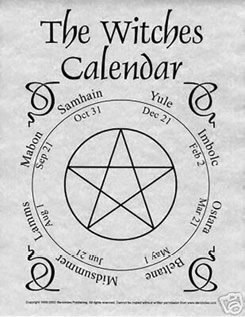
Pagans tend to believe that if things can be changed on an individual level, they can ultimately be changed on a universal level by “skilled practitioners” who collectively seek to improve mankind and the universe itself. It sounds far-fetched, and it is, but before you dismiss paganism as an insignificant system of beliefs (i.e., a religion), remember that just as the blind religion of evolution supposedly requires lots of time to bring about changes, the cosmic flow of positive energy takes time to redirect for the good of all. This is pagan thinking that borrows from a variety of sources from New Age to animism to Greek mythology.
The earth is supposed to have been around for a long time, so the pagan sees his religion more in the long term. He or she is just part of the circle of life occupying a sacred place on a planet in a vast universe for a certain amount of time and making the best of it. And for many, the pagan lifestyle is entertaining in the short term. It’s like Halloween every day. They take their paganism seriously but have fun doing it. Just think of how many children and adults were spellbound by J.K. Rowling’s Harry Potter books with sales totaling in the hundreds of millions. Fantasy yes, but some Potter fanatics delved deeper and deeper into the pagan, occult world of spiritual darkness.
According to a 2011 census, “Jedi” is now the most popular faith in the Other Religions category in England and Wales, taking seventh place among all the major world religions.21 It is a church inspired by George Lucas’s Star Wars films. The website of the Jedi Church states:
The Jedi church believes that there is one powerful force [energy field] that binds all things in the universe together. The Jedi religion is something innate inside every one of us, the Jedi Church believes that our sense of morality is innate. So quiet your mind and listen to the force within you.22
As the familiar saying goes, “buyer beware” — the Jedi religion is paganism pure and simple. The Jedi Church even warns its members to be cautious of the dark side of the force. It’s territory that no Jedi should dare to enter. But how is someone to know when he crosses over from the light side of the force to the dark side by simply listening to the voice within? By what standard can good and bad be judged in this pagan belief? It would be arbitrary to assert some absolute good or evil in a religion where no absolutes, like the claims of Jesus Christ, are tolerated! In truth, there is no such thing as a light side of paganism. It’s all darkness and it is a consuming darkness, like voodoo, which originated in sub-Saharan Africa that claims to be used to heal or to harm.
Pagan Polytheism
Paganism has some lofty spiritual goals, but it amounts to false worship based on teachings that are contrary to the Christian faith. It is both polytheistic (a belief in many gods) and pantheistic (all is god). It sprang from the seeds of polytheism sown in many different soils as people spread across the globe after the dispersion at Babel (Genesis 11). The pagan pantheon is composed of a variety of gods and goddesses, and the pagan may establish a close relationship with one or more of these gods. The spread of Hinduism in the West has also contributed much to the development of pagan thought and practice. An article on the history of modern paganism on the British Broadcasting Corporation website highlights this fact:
The 1960s and 1970s were times of radical social change. Hinduism and Taoism helped shape contemporary Paganism as the hippy trail led people to become interested in Eastern religions and philosophies. North Americans rediscovered Native American traditions and the Afro-American traditions of Santeria, Candomble, and Vodoun. Paganism found an ally in the ecological and feminist movements of the 1960s. Pagan philosophies appealed to many eco-activists, who also saw Nature as sacred and recognized the Great Goddess as Mother Nature. The image of the witch was taken up by feminists as a role-model of the independent powerful woman, and the single Great Goddess as the archetype of women’s inner strength and dignity.23
Thou Shalt Have No Other Gods
The first commandment that God gave to Moses on Mount Sinai was: “I am the Lord thy God, which have brought thee out of the land of Egypt, out of the house of bondage. Thou shalt have no other gods before me” (Exodus 20:2–3). The Israelites were also warned about the diverse occult practices of the nations they would encounter:
When thou art come into the land which the Lord thy God giveth thee, thou shalt not learn to do after the abominations of those nations. There shall not be found among you any one that maketh his son or his daughter to pass through the fire, or that useth divination, or an observer of times, or an enchanter, or a witch. Or a charmer, or a consulter with familiar spirits, or a wizard, or a necromancer. For all that do these things are an abomination unto the Lord: and because of these abominations the Lord thy God doth drive them out from before thee (Deuteronomy 18:9–12).
Rather than obey God, the Israelites failed to heed the Word of the Lord and fell into pagan idol worship and spiritism — the very thing God had warned them against in Deuteronomy 4:15–19. King Saul even went so far as to seek counsel from a medium called the witch of Endor (1 Samuel 28:1–8). In the New Testament, we read about Paul’s trip to ancient Athens and the grief he experienced over what he saw: “Now while Paul waited for them at Athens, his spirit was stirred in him, when he saw the city wholly given to idolatry” (Acts 17:16). In Romans 1, we learn that when people fail to worship God as their Creator, they begin to worship the creation:
For the invisible things of him from the creation of the world are clearly seen, being understood by the things that are made, even his eternal power and Godhead; so that they are without excuse: Because that, when they knew God, they glorified him not as God, neither were thankful; but became vain in their imaginations, and their foolish heart was darkened. Professing themselves to be wise, they became fools, and changed the glory of the uncorruptible God into an image made like to corruptible man, and to birds, and fourfooted beasts, and creeping things (Romans 1:20–23).
Christian author A.W. Tozer put it well: “Wrong ideas about God are only the fountain from which the polluted waters of idolatry flow; they are themselves idolatrous. The idolater simply imagines things about God and acts as if they were true.”24 The irrationalism of paganism is the belief in the multiplicity of gods, or no gods at all. Not all pagans believe the same about deity and divinity. Some make a distinction between the terms. Davy writes:
“Deity” is a nonspecific word for divine beings, goddesses and gods, and The God and the Godess. Divinity is a more generic word for the sacred, not necessarily quantifiable as a distinct class of beings. Practitioners generally feel that belief in divinity is not a useful way of looking at Pagan religious practice, pointing to the strangeness of the idea one must “believe” in something to relate to it.25
Norm Geisler notes:
Some neopagans debate about the ontological state of their “gods,” assigning an idealistic or aesthetic role to them. But as one put it, “All these things are within the realm of possibility. It has been our nature to call these ‘god.’ ”26
The confusion over the reality and nature of the gods in paganism is not a matter of confusion in the Scriptures. There is only one true God who created all things; all other gods and goddesses are false gods. They have no existence:
For though there be that are called gods, whether in heaven or in earth, (as there be gods many, and lords many,) But to us there is but one God, the Father, of whom are all things, and we in him; and one Lord Jesus Christ, by whom are all things, and we by him. Howbeit there is not in every man that knowledge (1 Corinthians 8:5–7).
This is the pagan’s real problem. They have no knowledge of the truth found in God’s revelation of Holy Scripture and so they have opened themselves up to lying spirits posing as ancestral spirits, gods, goddesses, or other entities. “Now the Spirit speaketh expressly, that in the latter times some shall depart from the faith, giving heed to seducing spirits, and doctrines of devils” (1 Timothy 4:1). Christian researcher Dave Hunt sounds the warning:
In all pagan/nature religions there is a presumed cause-and-effect relationship between the ritual or ceremony performed and the obtaining of the power or healing or other blessing sought. The whole idea of pagan ceremonies — the rites of the shaman or witch, the burning of candles, the making of potions, the use of fetishes, etc. — is that they will (if done correctly) elicit a response from the gods or spirits.27
The further one goes down the path of spiritual deception, the harder it is to escape because paganism is one of Satan’s strongholds — it is a lie masquerading as enlightenment (2 Corinthians 11:4). The only hope for someone lost in its maze is the truth concerning Jesus Christ. He is the true light of the world who promised that those who follow him will not walk in darkness, but shall have the light of life (John 8:12).
The Pagan View of Jesus
One of the tests of a lying spirit is what it professes about Jesus:
Who is a liar but he that denieth that Jesus is the Christ? He is antichrist, that denieth the Father and the Son. Whosoever denieth the Son, the same hath not the Father: he that acknowledgeth the Son hath the Father also (1 John 2:22–23).
Many pagans believe that Jesus did live at one time and was skilled in magical arts, which he passed on to his disciples, but that’s as far as most pagans take it. Ultimately, the answer to the question “who is Jesus?” would invoke a variety of opinions depending on the pagan you talk to (i.e., each may have a different opinion). For the most part, Jesus hardly appears on the pagan radar screen. He is not part of their belief system. But I must ask, “How can He be so ignored by so many pagans?” The American statesman Daniel Webster wrote: “All that is best in the civilization of today, is the fruit of Christ’s appearance among men.”28 And Webster is not alone in recognizing the significance of Jesus Christ:
I find the name of Jesus Christ written on the top of every page of modern history. (Historian George Bancroft)29
I am an historian, I am not a believer, but I must confess as a historian that this penniless preacher from Nazareth is irrevocably the very center of history. Jesus Christ is easily the most dominant figure in all history. (Author H.G. Wells)30
As the centuries pass by, the evidence is accumulating that measured by its effect on history, Jesus is the most influential life ever lived on this planet. (Historian Kenneth Scott Latourette)31
All history is incomprehensible without Christ. (Historian Ernest Renan)32
As a child I received instruction both in the Bible and in the Talmud. I am a Jew, but I am enthralled by the luminous figure of the Nazarene. . . . No one can read the Gospels without feeling the actual presence of Jesus. His personality pulsates in every word. No myth is filled with such life. (Albert Einstein)33
One thing that can be said for certain is that no pagan myth has the power to give life like Jesus did. In their defiance, pagans do not acknowledge Jesus as the Divine Son of God who came into the world to give them spiritual life. To possess spiritual life is what it means to be born again (John 3:5–7; 1 Peter 1:23; James 1:18).
Rejecting Christ, pagans stumble into their own destruction because Jesus said: “If ye believe not that I am he, ye shall die in your sins” (John 8:24). If you die in your sins, pagan or otherwise, you will spend eternity separated from the God in the lake of fire (Revelation 20:14).
Hell is not a state of mind; it’s a place that was prepared by God for the devil and his angels (Matthew 25:41). Pagans may scoff at the idea of a literal hell and eternal punishment, but Jesus didn’t. And if they refuse to repent (turn from their sin) and receive Jesus as Lord and Savior, they will ultimately learn of hell’s awful reality. Most of what we know of hell in the New Testament comes from Christ’s lips. In Revelation 1:18, Jesus said he had the controlling keys of death and hades (hell): “I am he that liveth, and was dead; and, behold, I am alive for evermore, Amen; and have the keys of hell and of death.”
Notice that the one who holds the keys of hell and death is the one who conquered death. Jesus was not a wise sage, or spiritual teacher who came on the scene and died like all men. Though He died on a Roman Cross, He rose from the dead and presently sits in the position of all authority at the right hand of His Father in heaven on the throne of God (Ephesians 1:17–20). All authority is His (Matthew 28:18). Christ’s Resurrection from the dead was proof that He is the eternal Son of God (Romans 1:14) and the foundation upon which the Christian faith rests. Without the Resurrection of Christ there would be no Christianity (1 Corinthians 15:13–19). One day the resurrected, historical Jesus is coming to judge the living and the dead.
The biblical case for the deity of Jesus is easy to make from Scripture (e.g., John 1; Colossians 1; Hebrews 1; etc.), but church history also affirms the fact. Quote after quote from Christian writers following the death of Apostles could be cited in this regard. Even some non-Christian sources testify to the Resurrection (e.g., the Jewish historian Josephus). I will not make the effort to do that here.
The belief in Jesus as divine was a fundamental doctrine of the early church and remains so today. Only those who were called heretics denied that Jesus was God manifest in the flesh. He suffered and died on the Cross as Savior of the world, rose again on the third day, ascended into heaven, and sits at the right hand of the father, waiting for the time He will come to judge the world in righteousness and establish His Kingdom. Contrary to some pagans’ claims, the Council of Nicaea in A.D. 325 did not invent the doctrine of the deity of Christ. Rather, the Council affirmed the apostolic teaching of who Christ is, “The one true God and the Second Person of the Trinity.” The proclamation states:
We believe in one God, the Father Almighty, Maker of heaven and earth, and of all things visible and invisible.
And in one Lord Jesus Christ, the only-begotten Son of God, begotten of the Father before all worlds; God of God, Light of Light, very God of very God; begotten, not made, being of one substance with the Father, by whom all things were made.
Who, for us men for our salvation, came down from heaven, and was incarnate by the Holy Spirit of the virgin Mary, and was made man; and was crucified also for us under Pontius Pilate; He suffered and was buried; and the third day He rose again, according to the Scriptures; and ascended into heaven, and sits on the right hand of the Father; and He shall come again, with glory, to judge the quick and the dead; whose kingdom shall have no end.34
There Is No Salvation in Paganism
God so loved the world, that he gave his only begotten Son, that whosoever believeth in him should not perish, but have everlasting life. For God sent not his Son into the world to condemn the world; but that the world through him might be saved (John 3:16–17).
Many people have seen John 3:16 on a placard at a sporting event, but, like the general population, have become so accustomed to the message that it is largely ignored. But it should not be ignored; it is a message about the grace of God to pardon sinners so they can become the heirs of salvation. However, since pagans do not recognize the biblical view of sin — an offense against a Holy God for which he or she is accountable — they believe there is no need for salvation. So where does that leave them? All dressed up in pagan garb and nowhere to go?
Do they depart this life for another state of consciousness? Will they face another life on earth as taught in reincarnation? Once again, pagans are free to decide for themselves what happens when, not if, they die, and some of them put the afterlife in the category of useless speculation that detracts from the joy of living. But how do they really know? Any answer they give is merely arbitrary and hence, logically fallacious. To the pagan, dying, after all, is just as natural as living; it is for the human what it is for a tree. It’s part of sacred evolution; death as a return to the nature of one’s elements. This is a pagan postulate. But what does the Scripture say?
It is appointed unto men once to die, but after this the judgment (Hebrews 9:27).
Death is not an end to all existence as individuals, and there will be no second chances after death for those who die without Christ. Right now, pagans, as well as all people alive, are in a “grace period,” if you will. We all deserve to suffer eternal separation from our Creator for the sins we have committed against His divine law. The good news is that Jesus bore the punishment for our sins on the Cross, and salvation is freely available to all who believe. This is why Christians are missionary minded: “Knowing therefore the terror of the Lord, we persuade men” (2 Corinthians 5:11). We want people, including pagans, to be saved!
The terror of the Lord is real, but for the Christian, death holds no uncertainty or apprehension: “We are confident, I say, and willing rather to be absent from the body, and to be present with the Lord” (2 Corinthians 5:8). Death has lost its power over those who belong to Jesus Christ (1 Corinthians 15:55–56). It will be a wonderful day of rejoicing when faith in Christ is turned into sight:
But as it is written, Eye hath not seen, nor ear heard, neither have entered into the heart of man, the things which God hath prepared for them that love him. But God hath revealed them unto us by his Spirit: for the Spirit searcheth all things, yea, the deep things of God (1 Corinthians 2:9–10).
In paganism, since no single belief in the afterlife is normative, nobody knows for sure what will occur. This uncertainty comes from a lack of an authoritative revelation. Pagans think they have an ultimate spiritual destination in mind, whatever they may call it, but they have no reliable map to get them there. Christian philosopher Gordon Clark underscores the dilemma of pagan religion:
The beclouding effects of sin upon the mind as it tries to discover God and salvation in nature may best be seen in the divergent results obtained among the pagan religions. The ancient Babylonians, Egyptians, and Romans looked on the same nature that is seen by the modern Moslem, Hindu, and Buddhist. But the messages that they purport to receive are considerably different.35
Who Is in Charge?
Neo-paganism has no single authoritative book like the Bible. Therefore, they have no written creed, or standards acceptable to all pagans, which dictate what they do. This is an important distinction between paganism and Christianity. Unlike Christianity, paganism makes few absolute truth claims, but there are some basic beliefs that most pagans would generally hold to. One key view is the postmodern belief that truth is relative (it may change depending on the circumstances).
Pagans prefer situational ethics to moral absolutes. What might be right for one pagan could be wrong for another. An example of this would be in the diets pagans follow. Some are strict vegetarians while others are not. Some are heterosexual and others homosexual. Many are dedicated feminists; others are not. Paganism delights in personal choice and diversity. Oddly enough, pagans tend to think that the lack of written dogma unites them more than a universal statement of beliefs. It gives birth to self-expression, and pagans love to borrow techniques from one another. The more learned are still quick to teach the beginners the pagan way.
For many pagans, the lack of an ultimate authority is what made paganism attractive to them. Why become a disciple of some religious teacher when you can be your own spiritual master? Whatever it takes to be a good pagan and work for human enlightenment and progress is acceptable so long as it does no harm. Pagans are not interested in following a list of commandments like those found in Judaism or Christianity. Pagans do not like to feel guilty about anything. The closest thing one can find to a code of conduct would be the Wiccan Rede (counsel). There are long versions of the Rede and short versions that embody the idea of doing whatever you desire so long as you do not harm anyone. But in a relativistic religion (no absolute right and wrong), how do you determine what is harmful?
Some Wiccans also hold to a three-fold law that basically teaches that whatever you do will come back upon you magnified many times over. This is close to the Hindu concept of cause and effect stated in the law of karma.
Even as I have seen, they that plow iniquity, and sow wickedness, reap the same (Job 4:8).
Instead of using a God-given conscience or revealed truth, the neo-pagan determines right and wrong for himself or herself, albeit with certain self-imposed restraints — do no harm. This is their golden rule, but it is a very subjective method of morality. What constitutes harm? Is abortion harmful to an unborn baby? Is it permissible to take recreational drugs without harming the body? Is lying with good intention permissible? The problem is that an undefined moral law is no moral law at all. It is why some witches’ covens can perform certain rituals while they are naked. Skyclad is the term for ritual nudity. Starhawk believes that nudity establishes a bond among conveners. Gardner believed performing rituals in the nude was a sign of true freedom. It may be the freedom to do as one pleases, but it is condemned in the Bible as a sin of the flesh when it defies God’s Word. When Adam and Eve sinned in the garden, they hid themselves from God and covered their shameful nakedness:
And when the woman saw that the tree was good for food, and that it was pleasant to the eyes, and a tree to be desired to make one wise, she took of the fruit thereof, and did eat, and gave also unto her husband with her; and he did eat. And the eyes of them both were opened, and they knew that they were naked; and they sewed fig leaves together, and made themselves aprons. And they heard the voice of the Lord God walking in the garden in the cool of the day: and Adam and his wife hid themselves from the presence of the Lord God amongst the trees of the garden (Genesis 3:6–8).
For the Christian, the conscience is not a reliable guide. God has given man much more than a three-fold law. God has given his Word in the 66 books of the Bible. The Word of God tells the Christian what is right and what is wrong. “Thy word is a lamp unto my feet, and a light unto my path” (Psalm 119:105).
In Romans 3:20, Paul spoke of the law of God as that which brings the knowledge of sin. Psalm 119:11 reads: “Thy word have I hid in mine heart, that I might not sin against thee.” Because paganism lacks spiritual insight from the source of all wisdom and knowledge, the Lord Jesus, it lacks moral judgment. Therefore, pagans feel free to live without a doctrine of sin to inhibit them.
Christians live by the Word of God, which gives the true perspective on sin because God’s perspective is the only one that has not been tarnished by sin (e.g., Romans 1:28–32; 1 Timothy 4:1–3; 2 Timothy 2:24–26). But it also points us to the power to live a life pleasing to God through the Holy Spirit. The Christian has present joy and pleasures forevermore in the presence of God. “But as it is written, Eye hath not seen, nor ear heard, neither have entered into the heart of man, the things which God hath prepared for them that love him” (1 Corinthians 2:9). The pagan has myths and magic. Belief in magic among pagans is based on the idea that changing one thing can change other things because all things in the universe are connected. But no pagan magic can ever change the fate that awaits them if they continue in their present darkness. No magic spell or potion can make restitution for their sins or give them the hope of eternal life.
Final Analysis
In the end, paganism takes its place among the religions of the world, most of which lack inspired revelation, a clear path to God and His righteousness, and the certainty of final salvation. These things are found only in the inspired Word of God, the way of the Cross, and the promises of God:
All scripture is given by inspiration of God, and is profitable for doctrine, for reproof, for correction, for instruction in righteousness: That the man of God may be perfect, thoroughly furnished unto all good works (2 Timothy 3:16–17).
For the preaching of the cross is to them that perish foolishness; but unto us which are saved it is the power of God (1 Corinthians 1:18).
For all the promises of God in him are yea, and in him Amen, unto the glory of God by us (2 Corinthians 1:20).
The true father of paganism is the prince of darkness who comes to steal, kill, and destroy. Jesus came to give life, and life more abundantly (John 10:10). Everyone must choose whom they will follow. It’s one or the other.
I conclude this study on paganism with the exhortation of Joshua to the children of Israel as they were about to enter a land filled with pagan nations who practiced things God called abominations. They had a choice to make and so do each of us:
And if it seem evil unto you to serve the Lord, choose you this day whom ye will serve; whether the gods which your fathers served that were on the other side of the flood, or the gods of the Amorites, in whose land ye dwell: but as for me and my house, we will serve the Lord (Joshua 24:15).
To God be the glory!
Doctrine |
Teachings of Paganism |
|---|---|
God |
Pagans deny the existence of a supreme God. Various views are common, but worship or connection with various gods and goddesses (polytheism) are common, as well as worship of nature and the spirits of nature (pantheism or panentheism). |
Authority/Revelation |
The Bible is rejected as authoritative. Individual experience is esteemed above any form of authority. Various forms of spiritual meditation and altered states of consciousness are used to gain secret spiritual knowledge. |
Man |
Man is seen as a self-defining and self-determining individual who is part of the whole of nature. Details about the nature of man vary widely among pagans. |
Sin |
The idea of absolute moral truths is denied, especially as related to the Bible. Each individual pagan determines morality by practicing the general guideline of “do no harm.” |
Salvation |
There is no concept of salvation from a sinful nature. Various views on the nature of the afterlife are held by pagans. |
Creation |
The biblical account of creation is denied. Various views, including ancient pagan mythologies and various forms of evolution, are held by pagans. |

